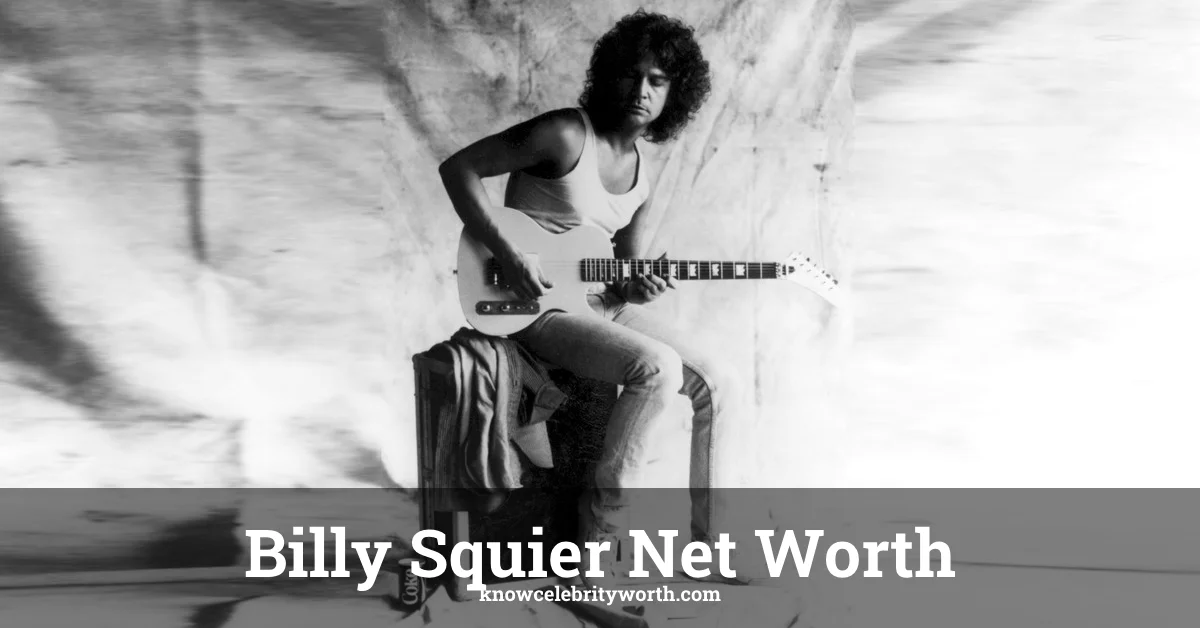Billy Squier stands among rock’s most sampled artists with a fortune of $80 million in 2025. The “Stroke” hitmaker built his wealth through album sales, concerts, and sampling deals with hip-hop artists like Eminem and Jay-Z. His financial growth spans four decades, from early MTV stardom to smart publishing deals that keep money flowing today.
Billy Squier Net Worth
Billy Squier’s net worth sits at $80 million as of 2025. This figure comes from music royalties, property investments, and smart business moves throughout his career. While some sources like The Richest report a lower $40 million figure, these estimates fail to account for his valuable music catalog and ongoing sampling income.
Squier made his mark as a rock musician and songwriter who blended hard rock with catchy hooks. His songs became staples on MTV and the radio during the 1980s. Unlike many rock stars who lost money through bad deals, Squier maintained control of his publishing rights and maximized his catalog value over time.
His $80 million net worth puts him ahead of many ’80s rock peers but below superstars like Bruce Springsteen ($650 million) or Bon Jovi ($410 million). For an artist with fewer chart-toppers than these giants, Squier’s financial success shows his business smarts matched his musical talent.
Billy Squier didn’t become rich overnight. His wealth grew steadily through key career moments:
- 1981: $5 Million After “Don’t Say No,” His breakthrough album, “Don’t Say No” went triple platinum, selling over 3 million copies. Hit singles “The Stroke” and “In The Dark” filled arenas and pushed his net worth to about $5 million. This early success laid the groundwork for bigger earnings.
- 1986: $15 Million From Sampling Boom By the mid-80s, hip-hop producers discovered Squier’s drum beats, especially from “The Big Beat.” Early sampling deals brought steady income, pushing his worth to roughly $15 million. These deals proved more valuable than anyone expected.
- 1993: $25 Million Through Publishing Rights. Smart publishing contracts in the early 90s secured Squier’s ownership stake in his music. As sampling grew more popular, his worth climbed to approximately $25 million. He negotiated better than many peers, keeping control of his most valuable assets.
- 2009: $50 Million With Digital Streaming. When music moved online, Squier’s catalog found new life. Streaming platforms and catalog reissues doubled his fortune to around $50 million. His songs became accessible to new generations of listeners and producers.
- 2025: $80 Million Current Value Today’s $80 million figure reflects decades of smart money moves. Recent licensing deals for commercials, TV shows, and films add steady income. His property investments have also grown in value, particularly his New York real estate.
Major Income Sources Behind His Fortune
Billy Squier’s wealth comes from multiple streams, not just album sales. His diversified income helped him avoid the financial troubles that plagued many rock stars.
1. Sampling Royalties: The Gift That Keeps Giving
Squier’s biggest money maker comes from hip-hop sampling. His drum beat from “The Big Beat” became one of music’s most sampled sounds. Artists who used his music include Jay-Z, Eminem, Kanye West, and dozens more.
These sampling deals earn Squier an estimated 75% royalty rate on each use, far above industry standards. Music industry experts value these rights at $30-40 million alone. Each new sample adds to his bank account without requiring new work.
The iconic “Big Beat” drum pattern appears in over 200 hip-hop songs, creating a steady revenue stream for decades. Unlike one-time payments, these royalties continue generating income each time the songs play on the radio, streaming platforms, or in commercials.
2. Album Sales & Concert Revenue
During his peak years (1981-1984), Squier sold over 12 million albums worldwide. “Don’t Say No” and “Emotions in Motion” both earned multi-platinum status. Even today, catalog sales add around $500,000 yearly to his income.
His arena tours during the early 80s grossed approximately $20 million. Though he tours less frequently now, occasional appearances at festivals and special events still bring substantial paydays. His music continues to sell steadily despite minimal promotion.
3. Publishing & Licensing Deals
Squier maintained ownership of his publishing rights – a smart move many artists fail to make. When his songs appear in movies, TV shows, or commercials, he earns both as a performer and a songwriter. Recent uses include popular shows like “Stranger Things” and “American Horror Story.”
These licensing deals typically pay $10,000-$50,000 per use, with high-profile placements commanding even more. His song “The Stroke” appeared in a national car commercial, likely earning a six-figure payday for a single use.
4. Real Estate Investments
Like many wealthy musicians, Squier invested in property. His most valuable holdings include:
- A penthouse in Manhattan’s San Remo building is worth approximately $12 million
- A Bridgehampton estate valued at around $8 million
- Additional properties in Florida and California
These real estate investments have appreciated significantly over the decades. The San Remo building famously housed many celebrities, including Bono from U2, with whom Squier once had a dispute over building renovations.
Career Highlights That Built His Empire
Squier’s financial success closely follows his musical achievements. Understanding his career helps explain how he built such substantial wealth.
Born in Massachusetts in 1950, Squier started playing guitar as a teenager. After fronting the band Piper in the 1970s, he launched his solo career in 1980 with “The Tale of the Tape.” His big break came with 1981’s “Don’t Say No,” which reached #5 on the Billboard charts.
“The Stroke,” his signature hit, peaked at #17 but became a cultural phenomenon. MTV put the video in heavy rotation, expanding his audience beyond radio listeners. The album sold over 3 million copies in the US alone.
His follow-up, “Emotions in Motion,” continued his success with hits like “Everybody Wants You.” The album went double platinum and cemented his status as a rock star. The tour supporting this album filled arenas nationwide.
Collaborations with Freddie Mercury and Queen producer Reinhold Mack added prestige to his catalog. Though later albums achieved less commercial success, his early hits maintained their value through consistent radio play and later sampling.
What separates Squier from many 80s rockers financially? He avoided the common pitfalls of substance abuse, excessive spending, and bad business deals. While his mainstream popularity faded after the mid-80s, his business decisions protected his wealth long-term.
Lifestyle and Key Assets
Despite his wealth, Squier lives more modestly than many rock stars. His lifestyle reflects careful management of his fortune rather than excessive spending.
His San Remo penthouse remains his primary residence. The pre-war building offers stunning Central Park views and houses numerous celebrities. Property records show he purchased it in the early 1990s for around $3 million – it’s now worth roughly $12 million.
The Bridgehampton estate serves as a summer retreat. The property includes a main house, a guest cottage, and a swimming pool on several acres. Real estate in this area has appreciated substantially, making this a smart investment.
Unlike some musicians who collect dozens of exotic cars, Squier maintains a small collection of classics, including vintage American models from the 1950s and 60s. His passion for guitars led to a valuable collection of rare instruments, including several 1950s Fender Stratocasters worth over $100,000 each.
Squier balances enjoying his wealth with preserving it. Financial advisors note his conservative investment approach focuses on steady growth rather than risky ventures.
Personal Life
Billy Squier married Nicole Schoen in 2002. Unlike many celebrity marriages, their relationship has remained stable, avoiding costly divorces that diminished many musicians’ fortunes. The couple splits time between their New York and Hamptons homes.
Philanthropy plays a role in Squier’s life, particularly supporting the Central Park Conservancy. Living beside the park influenced this choice, showing how his real estate decisions connect to his charitable interests.
Squier largely stepped back from touring in the 1990s after a controversial music video for “Rock Me Tonite” damaged his rock credibility. This career setback ultimately may have helped his finances by pushing him to focus on business opportunities rather than chasing hits.

Several factors point to continued financial growth:
- His catalog value increases as classic rock remains popular with advertisers and filmmakers
- Streaming platforms continue expanding globally, bringing their music to new audiences
- Hip-hop producers still sample his work regularly, creating new revenue streams
- His real estate continues to appreciate, particularly his New York properties
Music industry analysts predict his estate will become even more valuable after his lifetime, as often happens with musical catalogs. Proper estate planning could preserve his wealth for future generations.
Conclusion
Billy Squier built an $80 million fortune through smart business moves and musical talent. While he may not match the wealth of rock’s biggest names, his financial success exceeds many artists with similar commercial peaks.
His story offers lessons about the music business: maintain control of publishing rights, diversify income streams, and make smart investments. The value of his drum beats alone – sampled hundreds of times – shows how musical assets can generate income decades after creation.
His net worth story demonstrates how musicians can build lasting wealth beyond their years in the spotlight. While his name may not command headlines like in the 80s, his bank account continues growing through the timeless appeal of his music.
